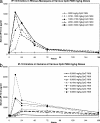Activation of innate immunity in healthy Macaca mulatta macaques by a single subcutaneous dose of GMP CpG 7909: safety data and interferon-inducible protein-10 kinetics for humans and macaques
- PMID: 18077623
- PMCID: PMC2238060
- DOI: 10.1128/CVI.00420-07
Activation of innate immunity in healthy Macaca mulatta macaques by a single subcutaneous dose of GMP CpG 7909: safety data and interferon-inducible protein-10 kinetics for humans and macaques
Abstract
Following a demonstration that mouse-optimized cytosine-guanosine dinucleotide (CpG) oligodeoxynucleotides stimulated innate immune protection against intracellular pathogens, we tested the ability of CpG 7909, a primate-optimized Toll-like receptor 9 (TLR9) agonist, to stimulate rhesus macaques to produce interferon-inducible protein-10 (IP-10), a biomarker of immune activation. This study was performed prior to a similar trial with humans in order to facilitate the development of CpG 7909 as an immunomodulator for biodefense. A single subcutaneous dose of clinical-grade CpG 7909 was given to four groups of healthy adult rhesus macaques (0-mg dose [n = 5], 0.75-mg dose [n = 9], 1.5-mg dose [n = 9], and 3.0-mg dose [n = 9]). Directed physical examination findings, clinical laboratory values, and serum IP-10 concentrations were collected at scheduled intervals for 28 days. All three dose levels of CpG 7909 were safe and not associated with significant clinical or laboratory abnormality. The time to peak serum IP-10 concentration was 1.0 days at the 0.75-mg dose and 0.5 days at the 1.5- and 3.0-mg doses. A dose-dependent response was observed for the magnitude and duration of IP-10 concentrations, which remained significantly above baseline for 3 days for the 3.0-mg and 1.5-mg dose groups but above baseline for only 2 days for the 0.75-mg dose group. There were no nonresponders to CpG 7909. These rhesus macaque safety and IP-10 response data closely parallel a subsequent phase 1 human study of subcutaneously administered CpG 7909. A single dose of clinical-grade CpG 7909 induced a rapid, sustained IP-10 response, a biomarker for activation of the innate immune system. Given the similar susceptibilities of humans and rhesus macaques to infectious diseases, the rhesus macaque appears to be a suitable model to evaluate the potential of CpG 7909-mediated innate immune activation to protect humans against pathogens.
Figures





References
-
- Abel, K., Y. Wang, L. Fritts, E. Sanchez, E. Chung, P. Fitzgerald-Bocarsly, A. M. Krieg, and C. J. Miller. 2005. Deoxycytidyl-deoxyguanosine oligonucleotide classes A, B, and C induce distinct cytokine gene expression patterns in rhesus monkey peripheral blood mononuclear cells and distinct alpha interferon responses in TLR9-expressing rhesus monkey plasmacytoid dendritic cells. Clin. Diagn. Lab. Immunol. 12:606-621. - PMC - PubMed
-
- Hartmann, G., R. D. Weeratna, Z. K. Ballas, P. Payette, S. Blackwell, I. Suparto, W. L. Rasmussen, M. Waldschmidt, D. Sajuthi, R. H. Purcell, H. L. Davis, and A. M. Krieg. 2000. Delineation of a CpG phosphorothioate oligodeoxynucleotide for activating primate immune responses in vitro and in vivo. J. Immunol. 164:1617-1624. - PubMed
-
- Hartmann, G., A. Marschner, P. R. Viveros, C. Stahl-Hennig, M. Eisenblätter, Y. S. Suh, E. Stefan, K. Tenner-Racz, K. Überla, P. Racz, R. M. Steinman, and R. Ignatius. 2005. CpG oligonucleotides induce strong humoral but only weak CD4+ T cell responses to protein antigens in rhesus macaques in vivo. Vaccine 23:3310-3317 - PubMed
Publication types
MeSH terms
Substances
LinkOut - more resources
Full Text Sources
Medical

